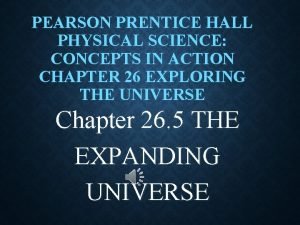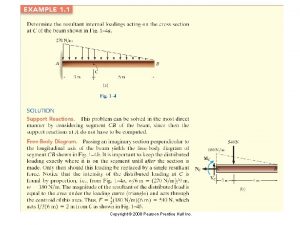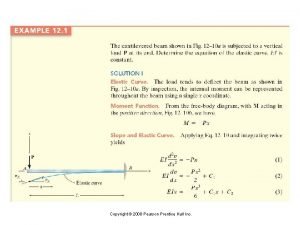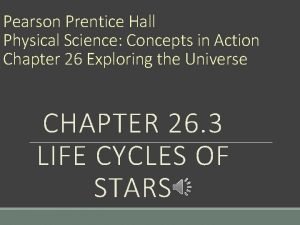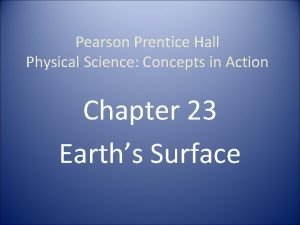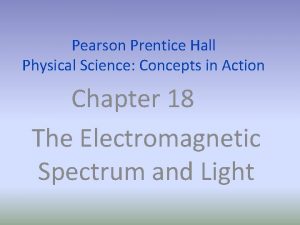Pearson Prentice Hall Physical Science Concepts in Action











- Slides: 11

Pearson Prentice Hall Physical Science: Concepts in Action Chapter 26 Exploring the Universe Chapter 26. 2 THE STARS

Measuring Distance • Def: a star is a large, glowing ball of gas in space which generates energy through nuclear fusion in its core • Def: a light-year is the unit of distance that light travels in a vacuum in one year

PARALLAX • Def: parallax is the apparent change in position of an object with respect to a distant background – – – Scientists use parallax to measure distances Hold your thumb at arm’s length in front of you and cover one eye Keep your thumb in the same spot & cover the other eye The apparent movement of your thumb is the parallax effect Astronomers measure the parallax of nearby stars to determine their distance from Earth https: //3. bp. blogspot. com/-5 adnzr 3 u. Mo. Q/Ur 4 ZEmb 5 x. DI/AAAAVC 0/Xbx. XMf. FHQd. I/s 1600/parallaxthumb. jpg http: //www. schoolsobservatory. org. uk/sites/default/files/astro/paraerth. jpg

Chemical and Physical Properties • Astronomers classify stars by: – – color, size, and brightness luminosity chemical composition and mass temperature • A star’s color indicates the temperature of its surface – The hottest stars are blue (30, 000 K) & – cool stars are red (3, 000 K) – Yellow stars (like our sun) are intermediate temperature (5, 000 -6, 000 K)

https: //image. slidesharecdn. com/classificationofstars-120326142454 -phpapp 01/95/classification-of-stars-3 -728. jpg? cb=1333520965

SPECTROSCOPY • Scientists get more precise information about a star by using color spectra & atomic absorption spectra (to indicate the presence of certain elements) https: //media 1. britannica. com/eb-media/02/96902 -004 -856 CCB 82. jpg

ABSORPTION LINES • Def: absorption lines are a set of dark lines that show where light has been absorbed in the atomic absorption spectra – Each star has its own atomic absorption spectrum which indicates which elements are present in the photosphere • Most stars have a chemical makeup that is similar to the sun • It is mostly hydrogen and helium making up nearly 99% of the star’s mass

APPARENT BRIGHTNESS • Def: apparent brightness is the brightness of a star as it appears from Earth • Brightness is affected by distance from Earth http: //www. star. ucl. ac. uk/~msw/teaching/PHAS 2 521/ism_dust_files/bright_dist. gif

ABSOLUTE BRIGHTNESS (luminosity) • Def: absolute brightness is how bright a light REALLY is • Absolute brightness does not depend on distance & it is calculated using distance in the calculation

How to Produce Energy • It wasn’t until the 1960 s that scientists discovered that the sun produces its energy in its core central region • The process is nuclear fusion – Recall that nuclear fusion has not happened on Earth yet because of the high temperatures required – The temperatures required for nuclear fusion exist on the sun http: //www. cfht. hawaii. edu/Instruments/Spectroscopy/Es padons/www. ast. obsmip. fr/users/donati/press/images/sun. jpg http: //resources. gale. com/gettingto greenr/files/2014/03/fusion_diagra m. jpg

MASS AND BRIGHTNESS • Astronomers: – can use information about temperature and brightness to estimate diameter (width) and calculate volume of a star – calculate mass indirectly by observing the gravitational interaction of stars that occur in pairs • There appears to be a relationship between absolute brightness and mass
 Prentice hall physical science concepts in action
Prentice hall physical science concepts in action 2011 pearson education
2011 pearson education Pearson education inc publishing as pearson prentice hall
Pearson education inc publishing as pearson prentice hall Pearson education inc publishing as pearson prentice hall
Pearson education inc publishing as pearson prentice hall Pearson 2012
Pearson 2012 Copyright 2008
Copyright 2008 Bacground
Bacground Chemical property definition
Chemical property definition Pearson physical science concepts in action
Pearson physical science concepts in action Kuiper belt def
Kuiper belt def Pearson prentice hall
Pearson prentice hall 2008 pearson prentice hall inc
2008 pearson prentice hall inc






